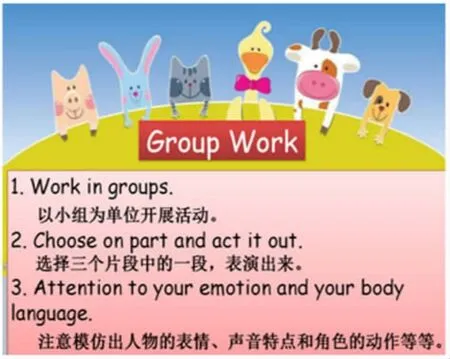The Day Without the Morning Call
——选自《攀登英语阅读》
2018-06-27郑幸子王爱华
郑幸子 王爱华
教学过程
Part 1.Pre-reading
1.Picture reading
T:Today we’ll learn a story.Look!This is the cover of the story book.So,what do you know from the cover?

There are several pictures of the story.Read carefully,you can get a lot of information from them.
Q1:What do you see?
Q2:What do you want to know about the story?
设计意图:首先,通过读故事封面,让学生学会认标题,知道封面中的图片代表什么。接着,从故事中精选有明显故事线索特点的图片,引导学生观察图片中人物的面部神态、肢体语言、图片内容等细节,获取信息,结合自身实际生活经验猜测发生了什么,或者将要发生什么。通过只呈现图片这一设疑的方式,让学生对故事保持好奇心,在下一阶段的学习中验证自己的猜测。此环节的目的在于通过反复的读图、思考、表达等一系列活动,让学生掌握阅读故事时读图的技巧,培养学生的思维能力,并推动故事向前展开。
2.Let’s watch!
Q1:Who are in the story?
A1:a cow/a hen/a donkey/a rooster.
Q2:Who makes the morning call?
A2:The rooster.
Q3:Is there a morning call next day?Why?
A3:No,there isn’t.The rooster is sleeping.
Q4:Is everything OK on the farm?
A4:No,everything is in a mess.
设计意图:通过将故事文本和音频直观形象地整体呈现给学生,让学生初步感知故事。教师设置的四个问题较为浅显,符合学生在短时间内阅读的认知水平,让学生在思考和回答问题时把握故事大意,并对故事的发展脉络有大致的了解。此环节也为接下来的精读故事环节做足铺垫。
Part 2.While reading
1.Intensive reading
(1)Roles and jobs
Q1:Who are in the story?Circle it!
Q2:What do they do?Underline it!
Cow give milk
Hen lay eggs
Donkey make bean curd
T:How to give milk/lay eggs/make bean curd?Can you show me?
T:What does the rooster do?
Ss:The rooster just walks around.
T:So,you see.Everyone does his job.A ll of them are very busy.But the rooster is walking around.He is not busy.
设计意图:通过让学生细读第一部分故事,引导学生采用圈出故事人物,画出他们在做什么这种标记式阅读的方式,梳理故事角色characters和他们所承担的工作,并利用TPR让学生操练、表演动作词组give milk/lay eggs/make bean curd/walk around。在教师夸张的表演和精准的示范带动下,学生们的表演欲被充分激发,跃跃欲试。学生的体验尝试为下一环节的表演打好基础、埋下表演的种子。
(2)Role-play
T:So this is the first part of the story.Let’s act out this part.I need a rooster!Group 1,you are cows.Group 2,you are hens...Group 6,you are donkeys.
Hi!Rooster/cow/hen/donkey!
Q1:What are you doing?
Q2:How do you feel?
Q3:Look at the rooster,do you feel angry?
Q4:What do you want to say to the rooster?
...
学生自由发言。
T:Everyone of you did a great job!Read the next part.And find out what they say to the rooster.
设计意图:在角色扮演中,请一名学生扮演rooster,其他学生分组扮演the cow,the hen and the donkey,通过模仿表演让学生更直接、深入体会角色的工作程度和心理活动。到处闲逛的rooster和忙碌着的动物们产生强烈反差,此时学生也能感同身受体会所扮演角色的心情。教师实时采访学生扮演动物时的感受,让学生直接表达内心的想法,同时教师给予适当帮助,这是学生提升语言运用能力的途径之一。动物们因为忙碌而“not happy”,故事自然而然过渡到下一部分。
(3)The cause of the story
T:Look at their faces and arms!How do they feel now?
Ss:Angry.
T:Let’s read with a angry tone!
T:Look at the rooster!His fingers!How dose the rooster feel?
Ss:Sad.
T:Let’s read with sadness!
(next picture)
T:Do they think his job is important?
Ss:No.
T:Look at the animals again!And how do they feel now?
Ss:Even angrier.
T:See.Their arms are like this!They stamp their foot and point at the rooster.They are very angry!Let’s read this part with a even angrier tone.OK?
T:Yeah!You do a good job again.They think the rooster’s job is not important,but they think their jobs are very important.What happens?
Ss:Look!The rooster is very busy.The animals make the rooster to do much work.
T:What is the work?
Ss:...massage me./get me some food.
T:Can you act it out?
Ss:Yes...
设计意图:教师引导学生观察图片中人物的表情、肢体动作,让学生明白这些动物在情绪上有变化,并引导学生模仿角色,通过夸张的语气和肢体动作,帮助学生深入体会人物的内心。教师帮助学生梳理故事发展的环节,完成板书内容。
(4)I am the busy rooster
T:You are the rooster.Put this on.
OK!I’ll devide you into 6 groups.This group say“Get me some tea!”OK?
T:“Give me some fruit!”
T:Ready?Go!...OK!Stop!
T:Hi,rooster!
How do you feel now?
What do you want to do now?
Ss:(Free talk.)
T:I have a question.What do you want to do now?
Ss:Sleep./Have rest.
T:Look!The rooster is sleepy.You do a good job!Give me five!
Q1:W ill he get up the next morning?
Q2:W ill he make the morning call?
设计意图:通过I am the busy rooster这一角色体验活动,让学生在扮演rooster时能够体会busy and tired的感受,并通过教师的帮助输出语言。教师通过设问rooster明天会不会起床打鸣,将故事过渡到下一片段。
(5)What happens in the next day
T:Look at the picture!Where are the anmals?
Ss:They are sleeping.
T:Is there a morning call?
Ss:No.
T:Look at the sun.It’s not happy!
T:Look at this picture.The plate is empty,The glass is empty,too.There is no breakfast.How does the farmer feel now?
Ss:Angry.
T:Look at his mouth.It is so big.And his eyes are wide...The farmer is very very angry.
Try to shout out like the farmer.“WAKE UP!You lazy BONES!”
T:And then the animals get up in a hurry.Is everything OK on the farm?
Ss:No,it is in a mess.
T:You see.They are scared.They fly here and run there,everything is in a mess.
Ah!Bang!
T:So without the morning call.What a mess!
设计意图:在教师的引导下,学生通过细读图片、文字等信息知道without the morning call的农场no breakfast/in a mess,从侧面体现出the morning call的重要性。以乱糟糟的工作场景和抱头受到惊吓的公鸡作为结尾图,这一开放式的结局正好适合教师作为情感教育的切入点,也可以让学生课后自编故事结尾。
(6)Retell the story

设计意图:教师通过PPT依次呈现图片和词条,并根据提示讲述故事。学生根据教师示范,尝试通过板书将故事完整地复述出来,借助板书梳理故事,巩固学生对故事发展脉络的掌握。
(7)Group work

教学设计:通过小组合作,学生们将自己喜欢的片断表演出来,不仅巩固了新知,而且在表演时也可以自创内容,发展语言综合运用能力。学生的合作表演也是进行情感教育的一个基石,小组中每个人的角色都是重要的,只要学会合作,才能共赢。
(8)Think and say
T:If you are the animals,what do you want to say to the rooster?
Ss:Sorry,your job is very important.
Without your morning call,everything is in a mess.
...
T:Now I have a last question to ask you.What do you learn or know from the story?
Ss:(Free talk)
T:Every job is very important.We should work together as a team.
In your group work,everyone of you are important.And your,work together makes the show perfect!Remember the teamwork,OK?
设计意图:故事的结局,教师设问,启发学生思考:如果你们是动物,你会对rooster说什么?教师再次引导学生思考,从故事中学到和知道了什么,展开情感教育,让学生明白每个人的工作都同等重要,我们应该学会合作共赢。
Part 3.Post reading
1.Homework
T:That’s what we learn today.So it’s time to give you homework.
(1)Make a new ending of the story and tell the story to your friends.
(2)Read more picture books after class.
T:So it’s time to say goodbye!
设计意图:通过完成布置家庭作业,巩固当天所学知识,引导学生拓展知识面,做到学有所用。
